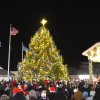Rare, unexpected convergence between Washington and Rehoboth
A group of young, diverse and passionate protesters took to the Bandstand and the steps of City Hall in Rehoboth Beach Monday evening this week. They demonstrated for justice and against police brutality in the wake of the recent death of George Floyd at the hands of a Minneapolis police officer.
The demonstration was an on-again, off-again affair. Organizers at first called for the gathering but then called it off. They reportedly feared their attempt at a peaceful demonstration would be hijacked by out-of-town, professional-grade looters and arsonists bent on seizing the opportunity to foment violence, destruction and theft. They had witnessed it in Dover and Wilmington on previous nights and didn’t want to be associated with that possibly happening in Rehoboth.
The momentum of their initial organization, however, coupled with the virulence of the cause, eclipsed attempts to call off the event. Between loud, sustained and sincere chants of Black Lives Matter, Silence Is Compliance, Remember George Floyd and Police the Police, speakers cautioned against hatred and violence while calling for sustained activism to ensure justice and positive change.
City and state police in strong numbers stood by to help keep the peace in a potentially volatile situation.
Coincidentally, at exactly the same time as the demonstration in the Nation’s Summer Capital, President Donald Trump was in the Rose Garden of the White House less than 100 miles to the west, similarly exercising his freedom of speech. He too said he wanted justice for George Floyd and his family, but at the same time wanted to halt violence and destruction that have accompanied demonstrations across the country, including in the nation’s capital city.
Then, in his mercurial fashion, protected by strong numbers of security forces, Trump left the confines of the White House grounds. The move was in marked contrast to the day before when he had been sequestered and bunkered in the White House, under siege from thousands of protesters outside.
He and other members of his administration marched past a park where peaceful protesters had been gathered, but were then reportedly dispersed by security using tear gas and rubber bullets. Earlier, the D.C. mayor had imposed a 7 p.m. curfew.
With a Bible in hand, the president headed for a nearby church to inspect damage inflicted by rioters the night before, creating what will probably become the hallmark images of his troubled presidency. They will undoubtedly be used by detractors and supporters alike during the electric campaigns underway for the November election.
His actions nonetheless comported with previous Tweets and phone conversations calling on governors across the country to take more aggressive action against the violence and to “dominate” protesters. In others words, for better or worse, President Trump put his money where his mouth was.
Widespread demonstrations, the coronavirus pandemic, and the pervasiveness of social media all speak to the interconnectedness and mutual concerns of all of our lives, and the importance of our First Amendment freedoms that keep us informed and responsible, and give the citizens of this nation such strength. Forewarned is forearmed.
Rioters with explosives
In times like these I often speak with Rep. Pete Schwartzkopf of Rehoboth Beach. As Speaker of Delaware’s House of Representatives, Schwartzkopf is in daily – sometimes hourly – contact with Gov. John Carney. Talking to the governor and other legislators from across the state this week, Schwartzkopf said he heard stories of people coming in from as far away as the state of Washington to literally add fire to demonstrations. He talked of outside agitators coming into Delaware with backpacks loaded with miniature sticks of dynamite. “They smash windows, loot, and then throw the explosives into the buildings to start fires.” He said a number of police officers, informed about the tactics from agencies across the country, were armed with fire extinguishers to put out fires before they really started rolling. “They apparently were a big help in holding down the damage,” said Schwartzkopf, a longtime Delaware State Police officer.
Pandemic’s toll continues
Memorial Day weekend traffic on Route 1 in Delaware’s Cape Region, according to information supplied by Delaware’s Department of Transportation, was down between 30 and 40 percent from Memorial Day weekend in 2019. According to the state’s Office of Highway Safety, there have been 32 fatalities in crashes on Delaware roads this year, as of May 27. By this time in 2019 there were 39. Only three of this year's fatalities have involved drugs or alcohol compared to 14 last year.
Also notable is the fact that 11 of this year’s fatalities have involved people who were not wearing seat belts compared to three at this point last year. Of this year’s 32 fatalities, 11 have been on Sussex roads.
Connections to the coronavirus? Draw your own conclusions.
The good news is that coronavirus deaths and hospitalizations continue to decline in Delaware, indicating that social distancing and masking have been effective, so far.























































